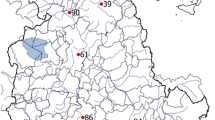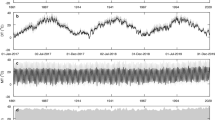Abstract
Compared with other large cities Vienna shows different urban development characteristics. The city has had a zero population growth during 1951–1995, a period of rapid growth elsewhere. In spite of its stagnating population of about 1,6 million Vienna has had development in other areas: a doubling of living floor space, a two and a half-fold increase in total energy consumption, a 60% rise of traffic area. In contrast, forests have been reduced by 20% and grasslands within the city borders by 30%. Of the 34 temperature recording stations in the study area of 1450 km2, nine series passed the quality tests after careful homogenization. Three of these were in the rural environment and were used as reference series for the urban temperature excess at the other six stations in the urbanized area. The urban excess temperatures vary from site to site: from 0.2 K in suburban areas up to 1.6 K in densely built-up areas. The Vienna case study illustrates two features of more than local interest which should be considered in urban climatology as well as in time series studies where the urban temperature excess is regarded as a bias. Firstly, in a city with constant population the urban heat excess shows significant to strongly significant trends of up to 0.6 K in 45 years due to changes in urban morphology and energy consumption. Secondly, the urban heat island and its trend cannot be regarded simply for the city as a whole. There are different absolute levels, different annual variations and different increases of the urban temperature excess in different parts of a city. The urban effect is more strongly influenced by the local surroundings of the site than by the city as a whole. So, if possible, urban heat islands should not be described by a two station approach only (the typical airport-downtown comparison), nor should it rely on regression between population number and heat island.
Similar content being viewed by others
Reference
Auer, I., Böhm, R., and Mohnl, H.: 1989, ‘Klima von Wien’, Beitr. z. Stadtforschung, Stadtentwicklung und Stadtgestaltung20, Magistrat der Stadt Wien, p. 270.
Beckel, L. and Zwittkovits, F.: 1988, Österreich - Satelliten-Bild-Atlas (Austrian Satellite Atlas), Druckhaus Nonntal Bücherdienst, Salzburg, p. 239.
Böhm, R. and Gabl, K.: 1978, ‘Die Wärmeinsel einer Großstadt in Abhängigkeit von verschiedenen meteorologischen Parametern’, Arch. Met. Geophys. Biokl., Ser. B 26, 219-237.
Böhm, R.: 1983, ‘Aktuelle Entwicklung der urbanen Wä:rmeinsel in Wien: Zeichnet sich eine Trendwende ab?’, Ann. Met., N.F. 20, 22-23.
Böhm, R.: 1992a, Lufttemperaturschwankungen in Österreich seit 1775, Österr. Beitr.Met. Geophys., Vol. 5, Central Institute for Met. and Geodyn, Vienna, p. 95.
Böhm, R.: 1992b, ‘Description of the Procedure of Homogenizing Temperature Time Series in Austria’, Central European Research Initiative, Proj. Group Meteorology, Working Paper2, p. 14.
Chandler, T. J.: 1964, ‘City Growth and Urban Climates’, Weather 19, 170-180.
Jones, P. D.: 1994, ‘Recent Warming in Global Temperature Series’, Geophys. Res. Lett. 21, 1149-1152.
Jones, P. D., Groisman, P. Ya., Coughlan, M., Plummer, N., Wang, W.-C., and Karl, T. R.: 1990, ‘Assessment of Urbanization Effects in Time Series of Surface Air Temperature over Land’, Nature 347, 169-172.
Karl, T. R., Diaz, H. F., and Kukla, G.: 1988, ‘Urbanization: Its Detection and Effect in the United States Climate Record’, J. Clim. 1, 1099-1123.
Landsberg, H. E.: 1981, The Urban Climate, Int. Geophys. Ser., Vol. 28, Academic Press, New York, p. 275.
Mitchell, J. M., Jr.: 1953, ‘On the Cause of Instrumentally Observed Secular Temperature Trends’, J. Meteorol. 10, 244-261.
Oke, T. R.: 1973, ‘City Size and the Urban Heat Island’, Atmos. Environ. 7, 769-779.
Oke, T. R.: 1981, ‘Canyon Geometry and the Urban Heat Island: Comparison of Scale Model and Field Observations’, J. Climatol. 1, 237-254.
Parry, M.: 1956, ‘Local Temperature Variations in the Reading Area’, Quart. J. Roy. Met. Soc. 82, 45-57.
Rudloff, H. v.: 1967, Die Schwankungen und Pendelungen des Klimas in Europa seit dem Beginn der regelmäßigen Instrumenten-Beobachtungen (1670), Vieweg, Braunschweig, p. 370.
Sandgruber, R.: 1995, Ökonomie und Politik - Österreichische Wirtschaftsgeschichte vom Mittelalterbis zur Gegenwart, Verl. Carl Ueberreuter, Wien, p. 668.
Statistische Jahrbücher der Stadt Wien (Statistical yearbooks of the City of Vienna) {dy1951} to 1995.
Author information
Authors and Affiliations
Rights and permissions
About this article
Cite this article
Böhm, R. Urban Bias in Temperature Time Series – a Case Study for the City of Vienna, Austria. Climatic Change 38, 113–128 (1998). https://doi.org/10.1023/A:1005338514333
Issue Date:
DOI: https://doi.org/10.1023/A:1005338514333




